LCBB4003: Organizational Structure and Culture of Bosch - Report
VerifiedAdded on 2022/12/17
|9
|2485
|74
Report
AI Summary
This report provides a comprehensive analysis of the organizational structure and culture of Bosch, a leading multinational engineering and technology company. It begins by defining organizational structure and culture and discussing their relationship to organizational performance, including the different types of organizational structures like hierarchical, flat, functional, divisional, ownership, and matrix structures, and how Bosch utilizes both ownership and matrix structures. The report then delves into Bosch's organizational culture, examining it through the lens of Hofstede's cultural dimensions model, and discussing the impact of factors such as power distance, uncertainty avoidance, individualism, masculinity, short-term/long-term orientation, and indulgence/restraint. The second part of the report discusses the effects of various factors, primarily personality traits as defined by the OCEAN model (Openness, Conscientiousness, Extraversion, Agreeableness, and Neuroticism), on individual behaviors within the organization, and concludes by summarizing the importance of organizational culture and behavior in driving organizational performance and stability, emphasizing equality as a key factor influencing individual behavior in the workplace. The report is based on the assignment brief for the module LCBB4003, Introducing the Modern Workplace.
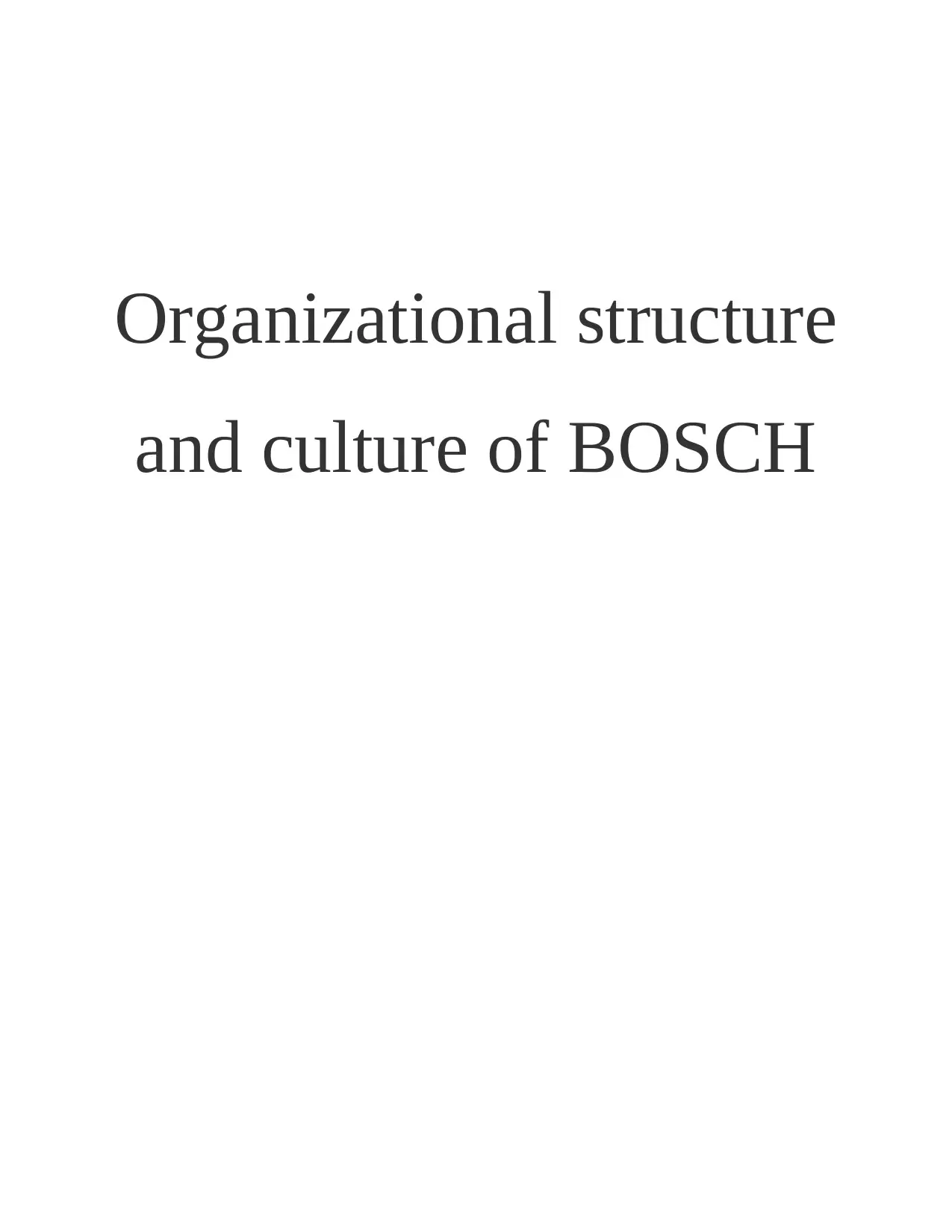
Organizational structure
and culture of BOSCH
and culture of BOSCH
Paraphrase This Document
Need a fresh take? Get an instant paraphrase of this document with our AI Paraphraser
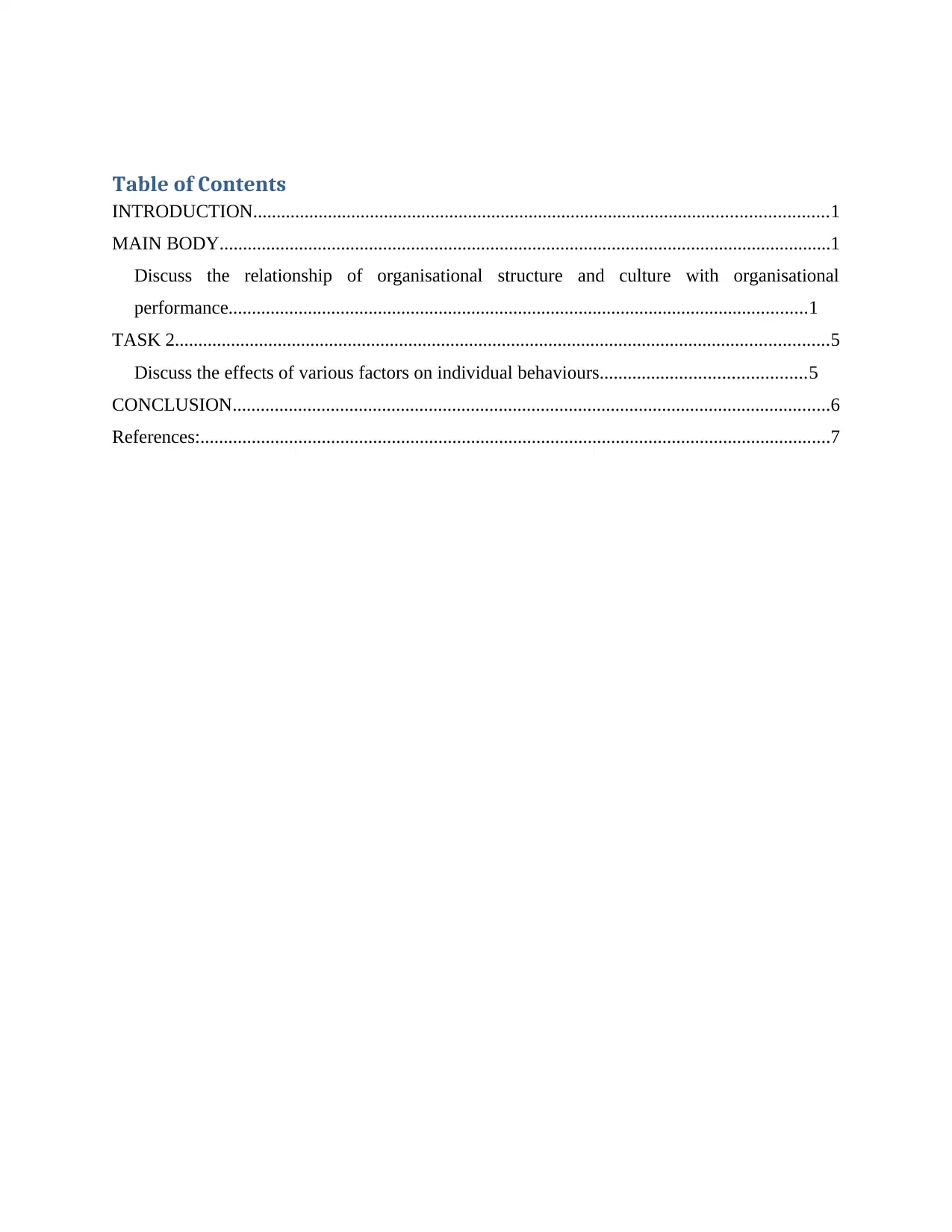
Table of Contents
INTRODUCTION...........................................................................................................................1
MAIN BODY...................................................................................................................................1
Discuss the relationship of organisational structure and culture with organisational
performance............................................................................................................................1
TASK 2............................................................................................................................................5
Discuss the effects of various factors on individual behaviours............................................5
CONCLUSION................................................................................................................................6
References:.......................................................................................................................................7
INTRODUCTION...........................................................................................................................1
MAIN BODY...................................................................................................................................1
Discuss the relationship of organisational structure and culture with organisational
performance............................................................................................................................1
TASK 2............................................................................................................................................5
Discuss the effects of various factors on individual behaviours............................................5
CONCLUSION................................................................................................................................6
References:.......................................................................................................................................7
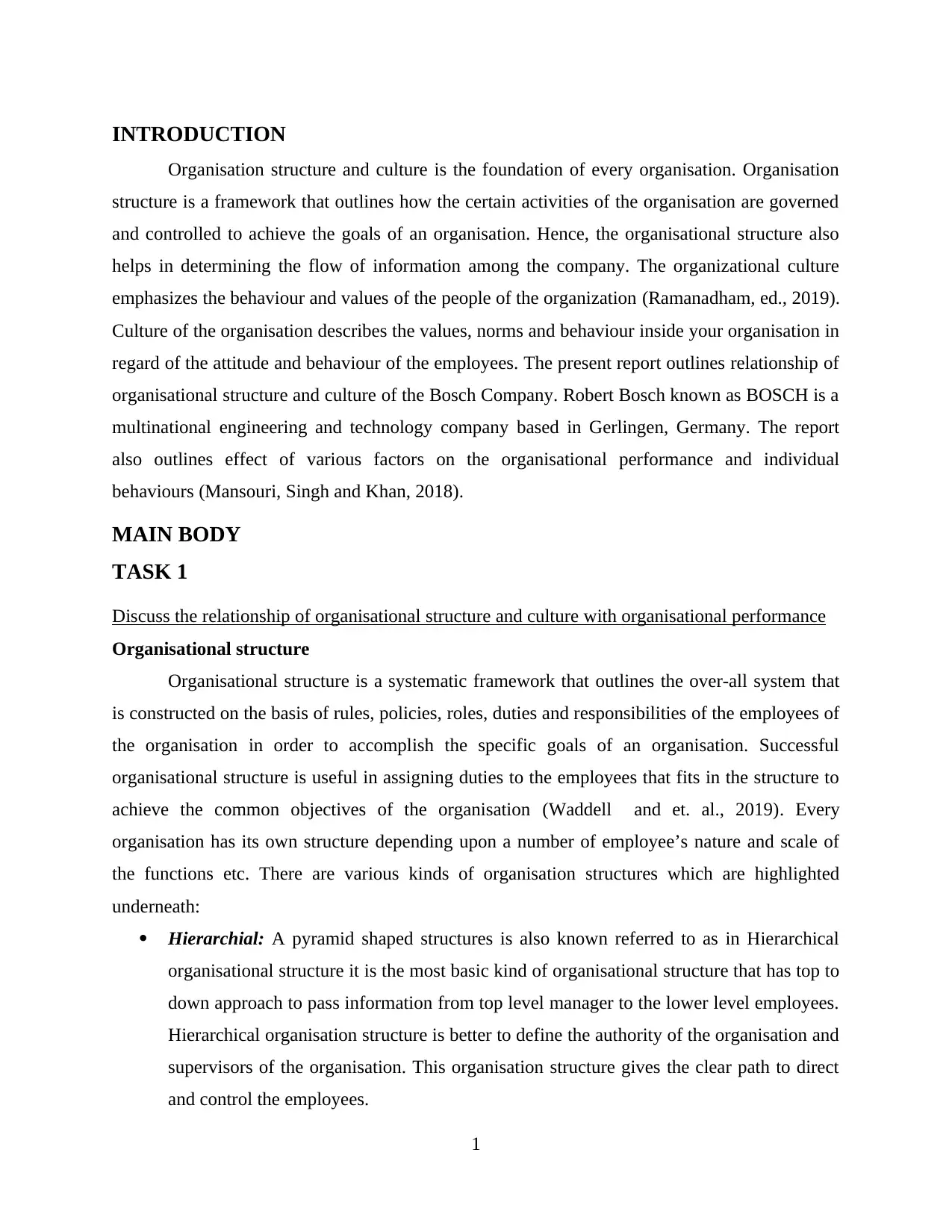
INTRODUCTION
Organisation structure and culture is the foundation of every organisation. Organisation
structure is a framework that outlines how the certain activities of the organisation are governed
and controlled to achieve the goals of an organisation. Hence, the organisational structure also
helps in determining the flow of information among the company. The organizational culture
emphasizes the behaviour and values of the people of the organization (Ramanadham, ed., 2019).
Culture of the organisation describes the values, norms and behaviour inside your organisation in
regard of the attitude and behaviour of the employees. The present report outlines relationship of
organisational structure and culture of the Bosch Company. Robert Bosch known as BOSCH is a
multinational engineering and technology company based in Gerlingen, Germany. The report
also outlines effect of various factors on the organisational performance and individual
behaviours (Mansouri, Singh and Khan, 2018).
MAIN BODY
TASK 1
Discuss the relationship of organisational structure and culture with organisational performance
Organisational structure
Organisational structure is a systematic framework that outlines the over-all system that
is constructed on the basis of rules, policies, roles, duties and responsibilities of the employees of
the organisation in order to accomplish the specific goals of an organisation. Successful
organisational structure is useful in assigning duties to the employees that fits in the structure to
achieve the common objectives of the organisation (Waddell and et. al., 2019). Every
organisation has its own structure depending upon a number of employee’s nature and scale of
the functions etc. There are various kinds of organisation structures which are highlighted
underneath:
Hierarchial: A pyramid shaped structures is also known referred to as in Hierarchical
organisational structure it is the most basic kind of organisational structure that has top to
down approach to pass information from top level manager to the lower level employees.
Hierarchical organisation structure is better to define the authority of the organisation and
supervisors of the organisation. This organisation structure gives the clear path to direct
and control the employees.
1
Organisation structure and culture is the foundation of every organisation. Organisation
structure is a framework that outlines how the certain activities of the organisation are governed
and controlled to achieve the goals of an organisation. Hence, the organisational structure also
helps in determining the flow of information among the company. The organizational culture
emphasizes the behaviour and values of the people of the organization (Ramanadham, ed., 2019).
Culture of the organisation describes the values, norms and behaviour inside your organisation in
regard of the attitude and behaviour of the employees. The present report outlines relationship of
organisational structure and culture of the Bosch Company. Robert Bosch known as BOSCH is a
multinational engineering and technology company based in Gerlingen, Germany. The report
also outlines effect of various factors on the organisational performance and individual
behaviours (Mansouri, Singh and Khan, 2018).
MAIN BODY
TASK 1
Discuss the relationship of organisational structure and culture with organisational performance
Organisational structure
Organisational structure is a systematic framework that outlines the over-all system that
is constructed on the basis of rules, policies, roles, duties and responsibilities of the employees of
the organisation in order to accomplish the specific goals of an organisation. Successful
organisational structure is useful in assigning duties to the employees that fits in the structure to
achieve the common objectives of the organisation (Waddell and et. al., 2019). Every
organisation has its own structure depending upon a number of employee’s nature and scale of
the functions etc. There are various kinds of organisation structures which are highlighted
underneath:
Hierarchial: A pyramid shaped structures is also known referred to as in Hierarchical
organisational structure it is the most basic kind of organisational structure that has top to
down approach to pass information from top level manager to the lower level employees.
Hierarchical organisation structure is better to define the authority of the organisation and
supervisors of the organisation. This organisation structure gives the clear path to direct
and control the employees.
1
⊘ This is a preview!⊘
Do you want full access?
Subscribe today to unlock all pages.

Trusted by 1+ million students worldwide
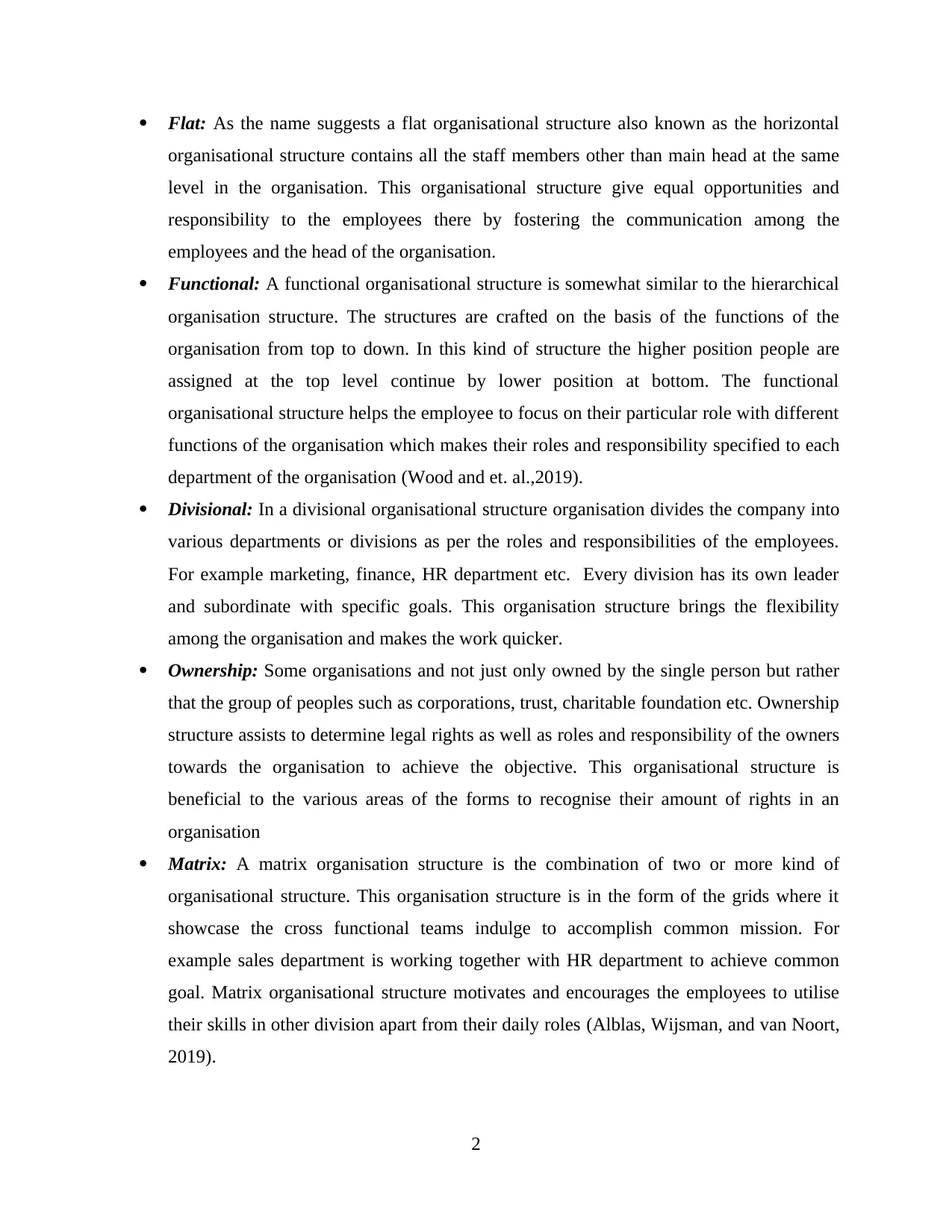
Flat: As the name suggests a flat organisational structure also known as the horizontal
organisational structure contains all the staff members other than main head at the same
level in the organisation. This organisational structure give equal opportunities and
responsibility to the employees there by fostering the communication among the
employees and the head of the organisation.
Functional: A functional organisational structure is somewhat similar to the hierarchical
organisation structure. The structures are crafted on the basis of the functions of the
organisation from top to down. In this kind of structure the higher position people are
assigned at the top level continue by lower position at bottom. The functional
organisational structure helps the employee to focus on their particular role with different
functions of the organisation which makes their roles and responsibility specified to each
department of the organisation (Wood and et. al.,2019).
Divisional: In a divisional organisational structure organisation divides the company into
various departments or divisions as per the roles and responsibilities of the employees.
For example marketing, finance, HR department etc. Every division has its own leader
and subordinate with specific goals. This organisation structure brings the flexibility
among the organisation and makes the work quicker.
Ownership: Some organisations and not just only owned by the single person but rather
that the group of peoples such as corporations, trust, charitable foundation etc. Ownership
structure assists to determine legal rights as well as roles and responsibility of the owners
towards the organisation to achieve the objective. This organisational structure is
beneficial to the various areas of the forms to recognise their amount of rights in an
organisation
Matrix: A matrix organisation structure is the combination of two or more kind of
organisational structure. This organisation structure is in the form of the grids where it
showcase the cross functional teams indulge to accomplish common mission. For
example sales department is working together with HR department to achieve common
goal. Matrix organisational structure motivates and encourages the employees to utilise
their skills in other division apart from their daily roles (Alblas, Wijsman, and van Noort,
2019).
2
organisational structure contains all the staff members other than main head at the same
level in the organisation. This organisational structure give equal opportunities and
responsibility to the employees there by fostering the communication among the
employees and the head of the organisation.
Functional: A functional organisational structure is somewhat similar to the hierarchical
organisation structure. The structures are crafted on the basis of the functions of the
organisation from top to down. In this kind of structure the higher position people are
assigned at the top level continue by lower position at bottom. The functional
organisational structure helps the employee to focus on their particular role with different
functions of the organisation which makes their roles and responsibility specified to each
department of the organisation (Wood and et. al.,2019).
Divisional: In a divisional organisational structure organisation divides the company into
various departments or divisions as per the roles and responsibilities of the employees.
For example marketing, finance, HR department etc. Every division has its own leader
and subordinate with specific goals. This organisation structure brings the flexibility
among the organisation and makes the work quicker.
Ownership: Some organisations and not just only owned by the single person but rather
that the group of peoples such as corporations, trust, charitable foundation etc. Ownership
structure assists to determine legal rights as well as roles and responsibility of the owners
towards the organisation to achieve the objective. This organisational structure is
beneficial to the various areas of the forms to recognise their amount of rights in an
organisation
Matrix: A matrix organisation structure is the combination of two or more kind of
organisational structure. This organisation structure is in the form of the grids where it
showcase the cross functional teams indulge to accomplish common mission. For
example sales department is working together with HR department to achieve common
goal. Matrix organisational structure motivates and encourages the employees to utilise
their skills in other division apart from their daily roles (Alblas, Wijsman, and van Noort,
2019).
2
Paraphrase This Document
Need a fresh take? Get an instant paraphrase of this document with our AI Paraphraser
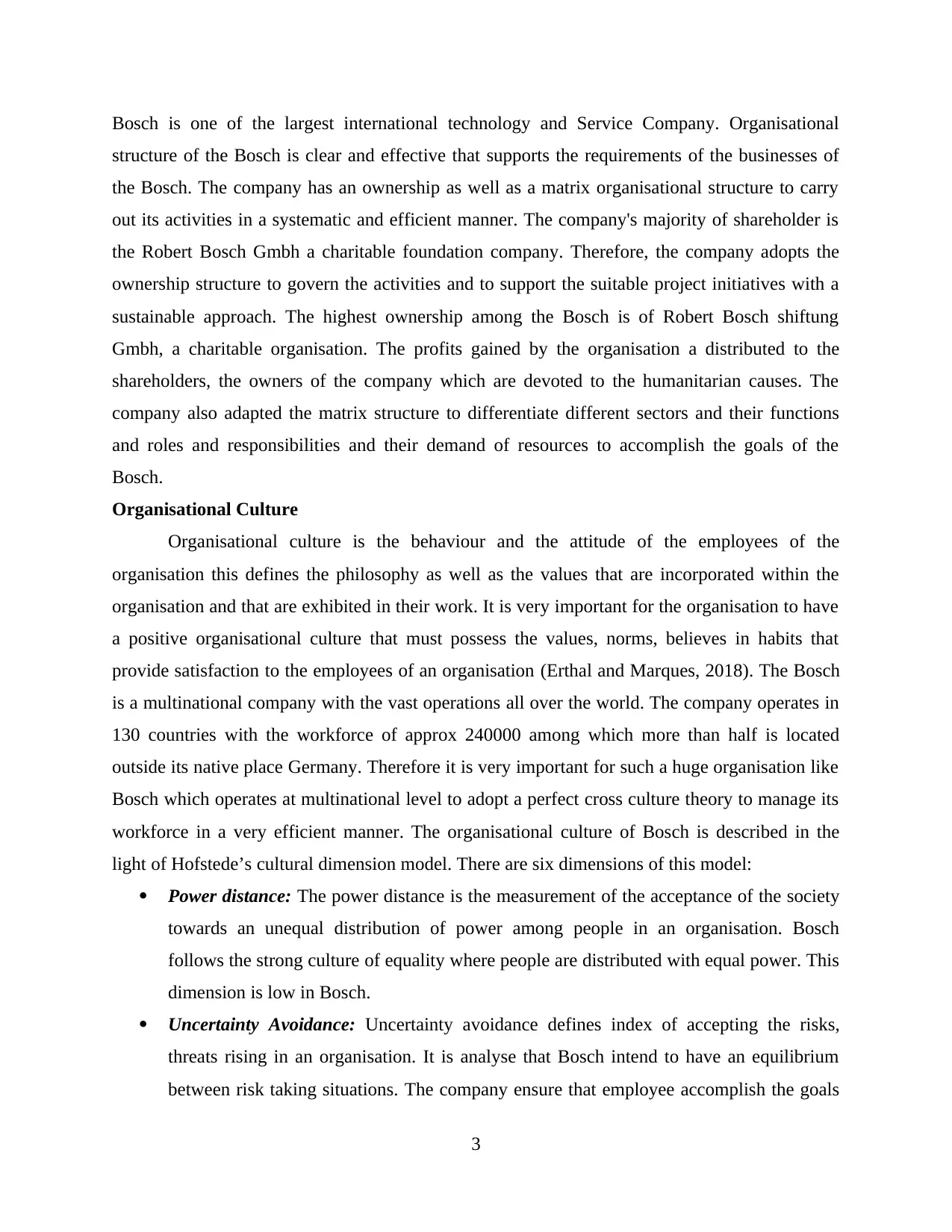
Bosch is one of the largest international technology and Service Company. Organisational
structure of the Bosch is clear and effective that supports the requirements of the businesses of
the Bosch. The company has an ownership as well as a matrix organisational structure to carry
out its activities in a systematic and efficient manner. The company's majority of shareholder is
the Robert Bosch Gmbh a charitable foundation company. Therefore, the company adopts the
ownership structure to govern the activities and to support the suitable project initiatives with a
sustainable approach. The highest ownership among the Bosch is of Robert Bosch shiftung
Gmbh, a charitable organisation. The profits gained by the organisation a distributed to the
shareholders, the owners of the company which are devoted to the humanitarian causes. The
company also adapted the matrix structure to differentiate different sectors and their functions
and roles and responsibilities and their demand of resources to accomplish the goals of the
Bosch.
Organisational Culture
Organisational culture is the behaviour and the attitude of the employees of the
organisation this defines the philosophy as well as the values that are incorporated within the
organisation and that are exhibited in their work. It is very important for the organisation to have
a positive organisational culture that must possess the values, norms, believes in habits that
provide satisfaction to the employees of an organisation (Erthal and Marques, 2018). The Bosch
is a multinational company with the vast operations all over the world. The company operates in
130 countries with the workforce of approx 240000 among which more than half is located
outside its native place Germany. Therefore it is very important for such a huge organisation like
Bosch which operates at multinational level to adopt a perfect cross culture theory to manage its
workforce in a very efficient manner. The organisational culture of Bosch is described in the
light of Hofstede’s cultural dimension model. There are six dimensions of this model:
Power distance: The power distance is the measurement of the acceptance of the society
towards an unequal distribution of power among people in an organisation. Bosch
follows the strong culture of equality where people are distributed with equal power. This
dimension is low in Bosch.
Uncertainty Avoidance: Uncertainty avoidance defines index of accepting the risks,
threats rising in an organisation. It is analyse that Bosch intend to have an equilibrium
between risk taking situations. The company ensure that employee accomplish the goals
3
structure of the Bosch is clear and effective that supports the requirements of the businesses of
the Bosch. The company has an ownership as well as a matrix organisational structure to carry
out its activities in a systematic and efficient manner. The company's majority of shareholder is
the Robert Bosch Gmbh a charitable foundation company. Therefore, the company adopts the
ownership structure to govern the activities and to support the suitable project initiatives with a
sustainable approach. The highest ownership among the Bosch is of Robert Bosch shiftung
Gmbh, a charitable organisation. The profits gained by the organisation a distributed to the
shareholders, the owners of the company which are devoted to the humanitarian causes. The
company also adapted the matrix structure to differentiate different sectors and their functions
and roles and responsibilities and their demand of resources to accomplish the goals of the
Bosch.
Organisational Culture
Organisational culture is the behaviour and the attitude of the employees of the
organisation this defines the philosophy as well as the values that are incorporated within the
organisation and that are exhibited in their work. It is very important for the organisation to have
a positive organisational culture that must possess the values, norms, believes in habits that
provide satisfaction to the employees of an organisation (Erthal and Marques, 2018). The Bosch
is a multinational company with the vast operations all over the world. The company operates in
130 countries with the workforce of approx 240000 among which more than half is located
outside its native place Germany. Therefore it is very important for such a huge organisation like
Bosch which operates at multinational level to adopt a perfect cross culture theory to manage its
workforce in a very efficient manner. The organisational culture of Bosch is described in the
light of Hofstede’s cultural dimension model. There are six dimensions of this model:
Power distance: The power distance is the measurement of the acceptance of the society
towards an unequal distribution of power among people in an organisation. Bosch
follows the strong culture of equality where people are distributed with equal power. This
dimension is low in Bosch.
Uncertainty Avoidance: Uncertainty avoidance defines index of accepting the risks,
threats rising in an organisation. It is analyse that Bosch intend to have an equilibrium
between risk taking situations. The company ensure that employee accomplish the goals
3
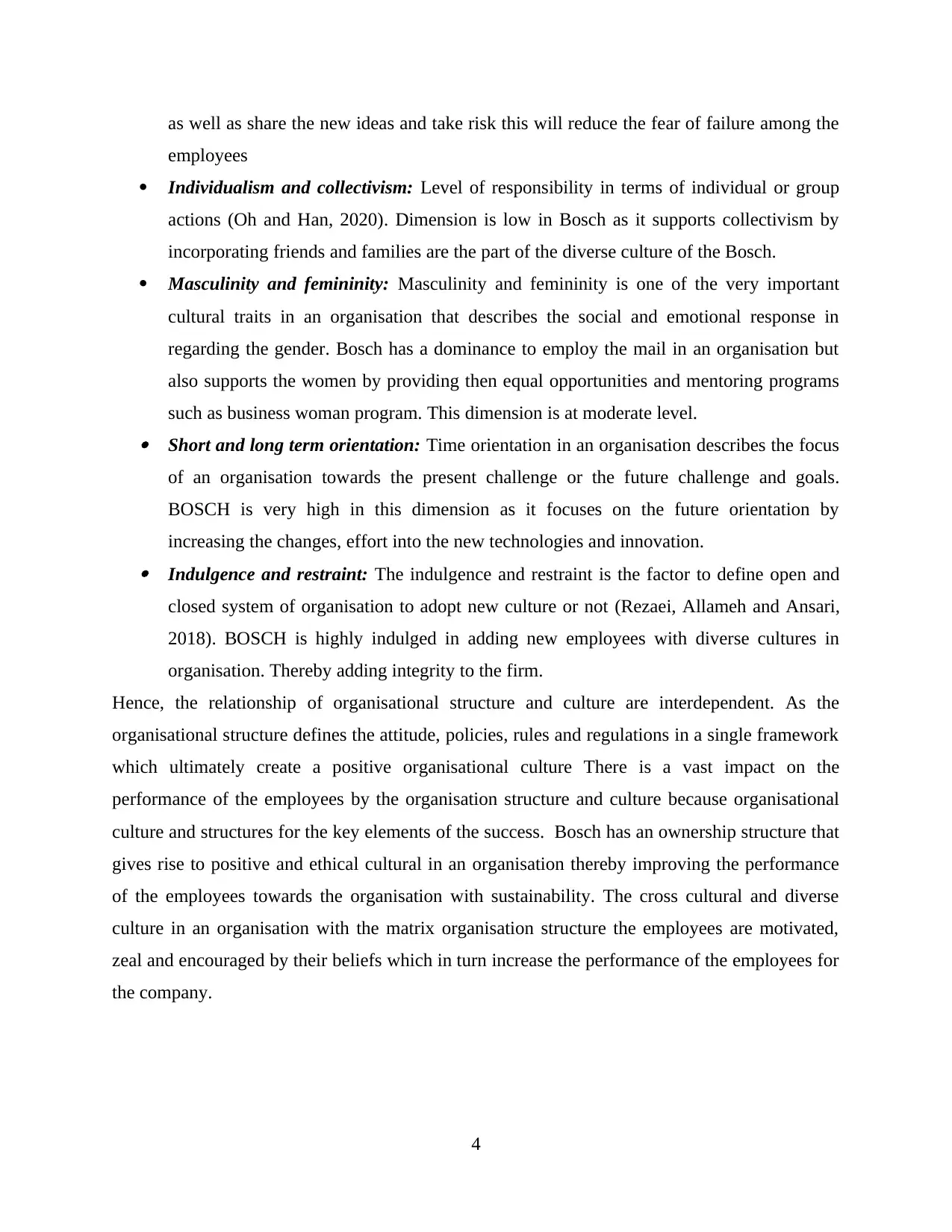
as well as share the new ideas and take risk this will reduce the fear of failure among the
employees
Individualism and collectivism: Level of responsibility in terms of individual or group
actions (Oh and Han, 2020). Dimension is low in Bosch as it supports collectivism by
incorporating friends and families are the part of the diverse culture of the Bosch.
Masculinity and femininity: Masculinity and femininity is one of the very important
cultural traits in an organisation that describes the social and emotional response in
regarding the gender. Bosch has a dominance to employ the mail in an organisation but
also supports the women by providing then equal opportunities and mentoring programs
such as business woman program. This dimension is at moderate level. Short and long term orientation: Time orientation in an organisation describes the focus
of an organisation towards the present challenge or the future challenge and goals.
BOSCH is very high in this dimension as it focuses on the future orientation by
increasing the changes, effort into the new technologies and innovation. Indulgence and restraint: The indulgence and restraint is the factor to define open and
closed system of organisation to adopt new culture or not (Rezaei, Allameh and Ansari,
2018). BOSCH is highly indulged in adding new employees with diverse cultures in
organisation. Thereby adding integrity to the firm.
Hence, the relationship of organisational structure and culture are interdependent. As the
organisational structure defines the attitude, policies, rules and regulations in a single framework
which ultimately create a positive organisational culture There is a vast impact on the
performance of the employees by the organisation structure and culture because organisational
culture and structures for the key elements of the success. Bosch has an ownership structure that
gives rise to positive and ethical cultural in an organisation thereby improving the performance
of the employees towards the organisation with sustainability. The cross cultural and diverse
culture in an organisation with the matrix organisation structure the employees are motivated,
zeal and encouraged by their beliefs which in turn increase the performance of the employees for
the company.
4
employees
Individualism and collectivism: Level of responsibility in terms of individual or group
actions (Oh and Han, 2020). Dimension is low in Bosch as it supports collectivism by
incorporating friends and families are the part of the diverse culture of the Bosch.
Masculinity and femininity: Masculinity and femininity is one of the very important
cultural traits in an organisation that describes the social and emotional response in
regarding the gender. Bosch has a dominance to employ the mail in an organisation but
also supports the women by providing then equal opportunities and mentoring programs
such as business woman program. This dimension is at moderate level. Short and long term orientation: Time orientation in an organisation describes the focus
of an organisation towards the present challenge or the future challenge and goals.
BOSCH is very high in this dimension as it focuses on the future orientation by
increasing the changes, effort into the new technologies and innovation. Indulgence and restraint: The indulgence and restraint is the factor to define open and
closed system of organisation to adopt new culture or not (Rezaei, Allameh and Ansari,
2018). BOSCH is highly indulged in adding new employees with diverse cultures in
organisation. Thereby adding integrity to the firm.
Hence, the relationship of organisational structure and culture are interdependent. As the
organisational structure defines the attitude, policies, rules and regulations in a single framework
which ultimately create a positive organisational culture There is a vast impact on the
performance of the employees by the organisation structure and culture because organisational
culture and structures for the key elements of the success. Bosch has an ownership structure that
gives rise to positive and ethical cultural in an organisation thereby improving the performance
of the employees towards the organisation with sustainability. The cross cultural and diverse
culture in an organisation with the matrix organisation structure the employees are motivated,
zeal and encouraged by their beliefs which in turn increase the performance of the employees for
the company.
4
⊘ This is a preview!⊘
Do you want full access?
Subscribe today to unlock all pages.

Trusted by 1+ million students worldwide
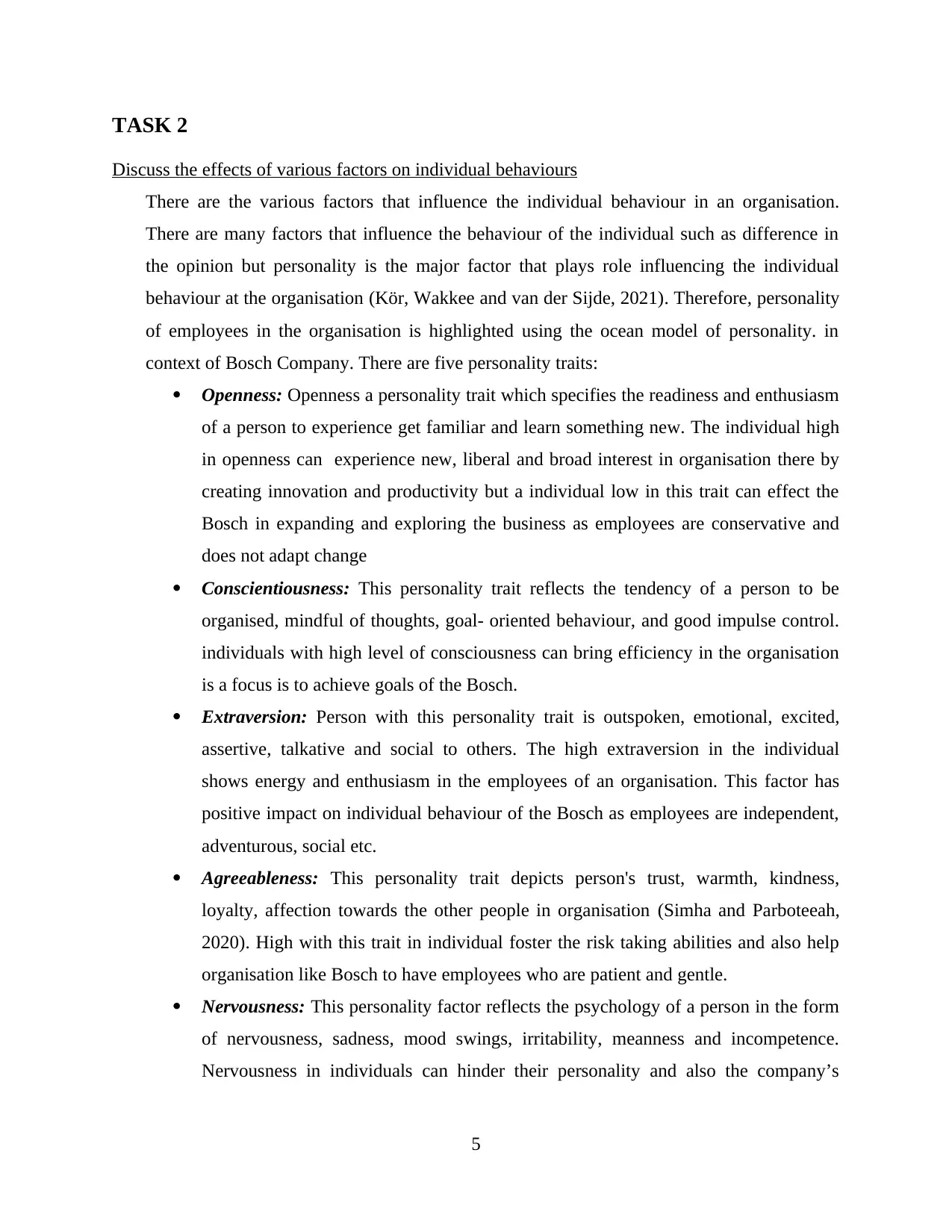
TASK 2
Discuss the effects of various factors on individual behaviours
There are the various factors that influence the individual behaviour in an organisation.
There are many factors that influence the behaviour of the individual such as difference in
the opinion but personality is the major factor that plays role influencing the individual
behaviour at the organisation (Kör, Wakkee and van der Sijde, 2021). Therefore, personality
of employees in the organisation is highlighted using the ocean model of personality. in
context of Bosch Company. There are five personality traits:
Openness: Openness a personality trait which specifies the readiness and enthusiasm
of a person to experience get familiar and learn something new. The individual high
in openness can experience new, liberal and broad interest in organisation there by
creating innovation and productivity but a individual low in this trait can effect the
Bosch in expanding and exploring the business as employees are conservative and
does not adapt change
Conscientiousness: This personality trait reflects the tendency of a person to be
organised, mindful of thoughts, goal- oriented behaviour, and good impulse control.
individuals with high level of consciousness can bring efficiency in the organisation
is a focus is to achieve goals of the Bosch.
Extraversion: Person with this personality trait is outspoken, emotional, excited,
assertive, talkative and social to others. The high extraversion in the individual
shows energy and enthusiasm in the employees of an organisation. This factor has
positive impact on individual behaviour of the Bosch as employees are independent,
adventurous, social etc.
Agreeableness: This personality trait depicts person's trust, warmth, kindness,
loyalty, affection towards the other people in organisation (Simha and Parboteeah,
2020). High with this trait in individual foster the risk taking abilities and also help
organisation like Bosch to have employees who are patient and gentle.
Nervousness: This personality factor reflects the psychology of a person in the form
of nervousness, sadness, mood swings, irritability, meanness and incompetence.
Nervousness in individuals can hinder their personality and also the company’s
5
Discuss the effects of various factors on individual behaviours
There are the various factors that influence the individual behaviour in an organisation.
There are many factors that influence the behaviour of the individual such as difference in
the opinion but personality is the major factor that plays role influencing the individual
behaviour at the organisation (Kör, Wakkee and van der Sijde, 2021). Therefore, personality
of employees in the organisation is highlighted using the ocean model of personality. in
context of Bosch Company. There are five personality traits:
Openness: Openness a personality trait which specifies the readiness and enthusiasm
of a person to experience get familiar and learn something new. The individual high
in openness can experience new, liberal and broad interest in organisation there by
creating innovation and productivity but a individual low in this trait can effect the
Bosch in expanding and exploring the business as employees are conservative and
does not adapt change
Conscientiousness: This personality trait reflects the tendency of a person to be
organised, mindful of thoughts, goal- oriented behaviour, and good impulse control.
individuals with high level of consciousness can bring efficiency in the organisation
is a focus is to achieve goals of the Bosch.
Extraversion: Person with this personality trait is outspoken, emotional, excited,
assertive, talkative and social to others. The high extraversion in the individual
shows energy and enthusiasm in the employees of an organisation. This factor has
positive impact on individual behaviour of the Bosch as employees are independent,
adventurous, social etc.
Agreeableness: This personality trait depicts person's trust, warmth, kindness,
loyalty, affection towards the other people in organisation (Simha and Parboteeah,
2020). High with this trait in individual foster the risk taking abilities and also help
organisation like Bosch to have employees who are patient and gentle.
Nervousness: This personality factor reflects the psychology of a person in the form
of nervousness, sadness, mood swings, irritability, meanness and incompetence.
Nervousness in individuals can hinder their personality and also the company’s
5
Paraphrase This Document
Need a fresh take? Get an instant paraphrase of this document with our AI Paraphraser
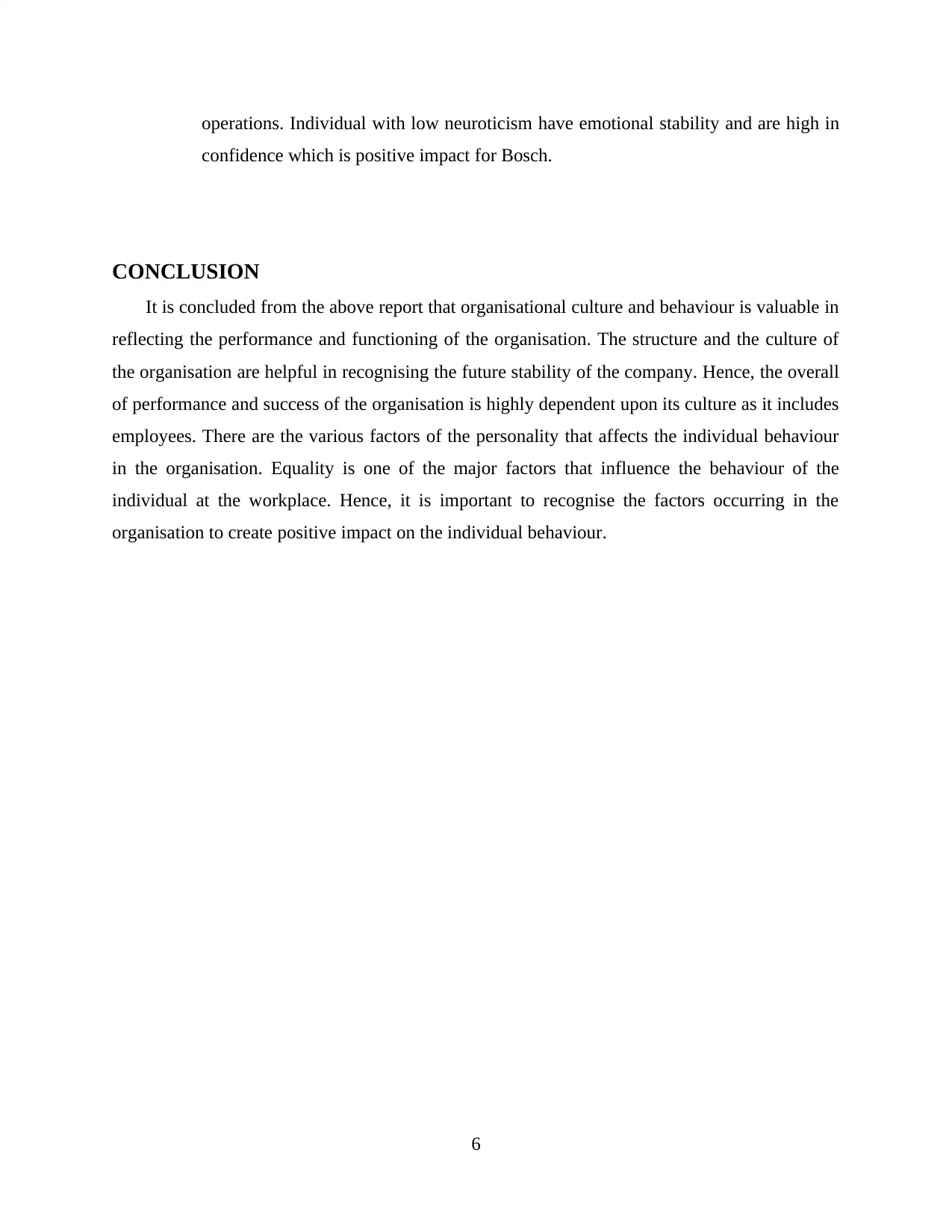
operations. Individual with low neuroticism have emotional stability and are high in
confidence which is positive impact for Bosch.
CONCLUSION
It is concluded from the above report that organisational culture and behaviour is valuable in
reflecting the performance and functioning of the organisation. The structure and the culture of
the organisation are helpful in recognising the future stability of the company. Hence, the overall
of performance and success of the organisation is highly dependent upon its culture as it includes
employees. There are the various factors of the personality that affects the individual behaviour
in the organisation. Equality is one of the major factors that influence the behaviour of the
individual at the workplace. Hence, it is important to recognise the factors occurring in the
organisation to create positive impact on the individual behaviour.
6
confidence which is positive impact for Bosch.
CONCLUSION
It is concluded from the above report that organisational culture and behaviour is valuable in
reflecting the performance and functioning of the organisation. The structure and the culture of
the organisation are helpful in recognising the future stability of the company. Hence, the overall
of performance and success of the organisation is highly dependent upon its culture as it includes
employees. There are the various factors of the personality that affects the individual behaviour
in the organisation. Equality is one of the major factors that influence the behaviour of the
individual at the workplace. Hence, it is important to recognise the factors occurring in the
organisation to create positive impact on the individual behaviour.
6
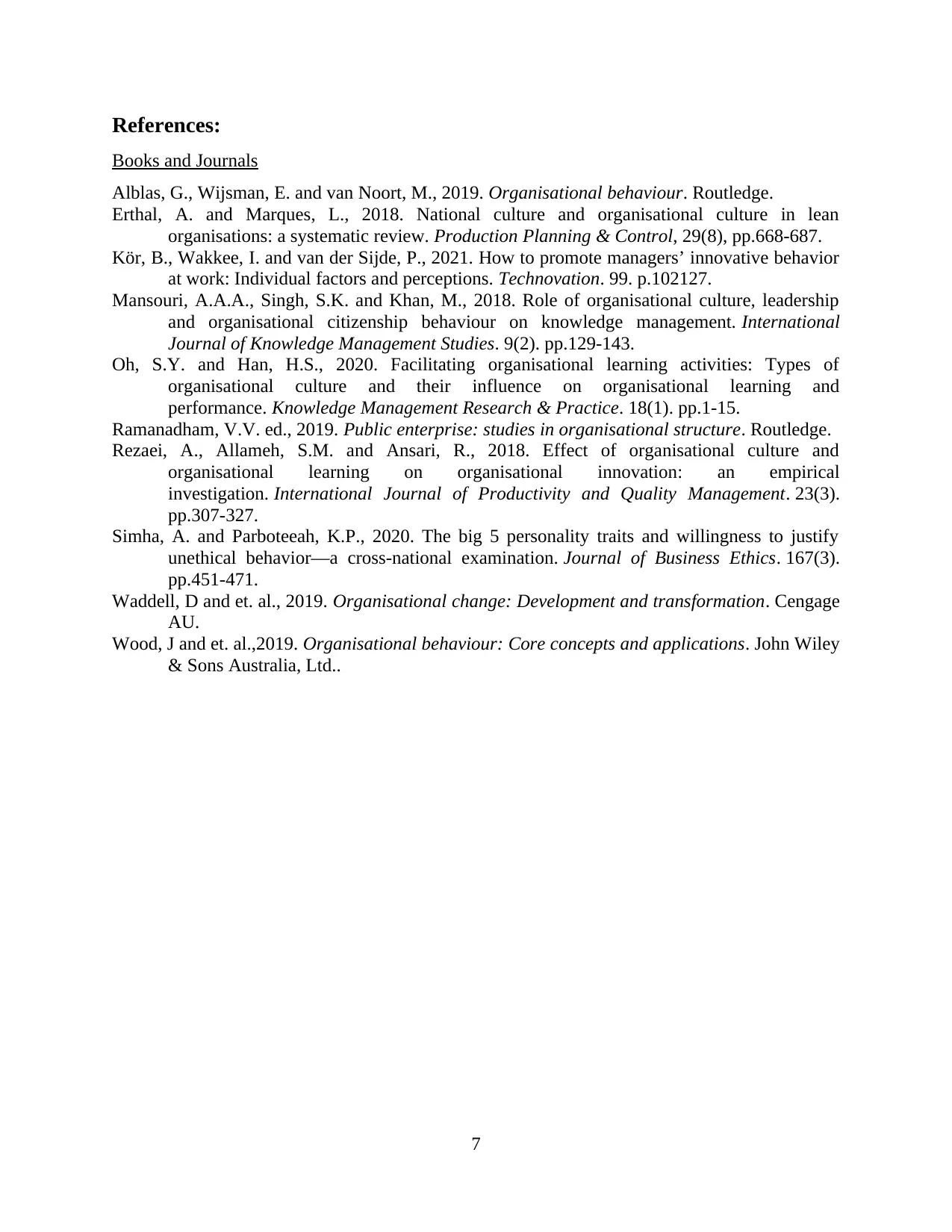
References:
Books and Journals
Alblas, G., Wijsman, E. and van Noort, M., 2019. Organisational behaviour. Routledge.
Erthal, A. and Marques, L., 2018. National culture and organisational culture in lean
organisations: a systematic review. Production Planning & Control, 29(8), pp.668-687.
Kör, B., Wakkee, I. and van der Sijde, P., 2021. How to promote managers’ innovative behavior
at work: Individual factors and perceptions. Technovation. 99. p.102127.
Mansouri, A.A.A., Singh, S.K. and Khan, M., 2018. Role of organisational culture, leadership
and organisational citizenship behaviour on knowledge management. International
Journal of Knowledge Management Studies. 9(2). pp.129-143.
Oh, S.Y. and Han, H.S., 2020. Facilitating organisational learning activities: Types of
organisational culture and their influence on organisational learning and
performance. Knowledge Management Research & Practice. 18(1). pp.1-15.
Ramanadham, V.V. ed., 2019. Public enterprise: studies in organisational structure. Routledge.
Rezaei, A., Allameh, S.M. and Ansari, R., 2018. Effect of organisational culture and
organisational learning on organisational innovation: an empirical
investigation. International Journal of Productivity and Quality Management. 23(3).
pp.307-327.
Simha, A. and Parboteeah, K.P., 2020. The big 5 personality traits and willingness to justify
unethical behavior—a cross-national examination. Journal of Business Ethics. 167(3).
pp.451-471.
Waddell, D and et. al., 2019. Organisational change: Development and transformation. Cengage
AU.
Wood, J and et. al.,2019. Organisational behaviour: Core concepts and applications. John Wiley
& Sons Australia, Ltd..
7
Books and Journals
Alblas, G., Wijsman, E. and van Noort, M., 2019. Organisational behaviour. Routledge.
Erthal, A. and Marques, L., 2018. National culture and organisational culture in lean
organisations: a systematic review. Production Planning & Control, 29(8), pp.668-687.
Kör, B., Wakkee, I. and van der Sijde, P., 2021. How to promote managers’ innovative behavior
at work: Individual factors and perceptions. Technovation. 99. p.102127.
Mansouri, A.A.A., Singh, S.K. and Khan, M., 2018. Role of organisational culture, leadership
and organisational citizenship behaviour on knowledge management. International
Journal of Knowledge Management Studies. 9(2). pp.129-143.
Oh, S.Y. and Han, H.S., 2020. Facilitating organisational learning activities: Types of
organisational culture and their influence on organisational learning and
performance. Knowledge Management Research & Practice. 18(1). pp.1-15.
Ramanadham, V.V. ed., 2019. Public enterprise: studies in organisational structure. Routledge.
Rezaei, A., Allameh, S.M. and Ansari, R., 2018. Effect of organisational culture and
organisational learning on organisational innovation: an empirical
investigation. International Journal of Productivity and Quality Management. 23(3).
pp.307-327.
Simha, A. and Parboteeah, K.P., 2020. The big 5 personality traits and willingness to justify
unethical behavior—a cross-national examination. Journal of Business Ethics. 167(3).
pp.451-471.
Waddell, D and et. al., 2019. Organisational change: Development and transformation. Cengage
AU.
Wood, J and et. al.,2019. Organisational behaviour: Core concepts and applications. John Wiley
& Sons Australia, Ltd..
7
⊘ This is a preview!⊘
Do you want full access?
Subscribe today to unlock all pages.

Trusted by 1+ million students worldwide
1 out of 9
Related Documents
Your All-in-One AI-Powered Toolkit for Academic Success.
+13062052269
info@desklib.com
Available 24*7 on WhatsApp / Email
![[object Object]](/_next/static/media/star-bottom.7253800d.svg)
Unlock your academic potential
Copyright © 2020–2025 A2Z Services. All Rights Reserved. Developed and managed by ZUCOL.





